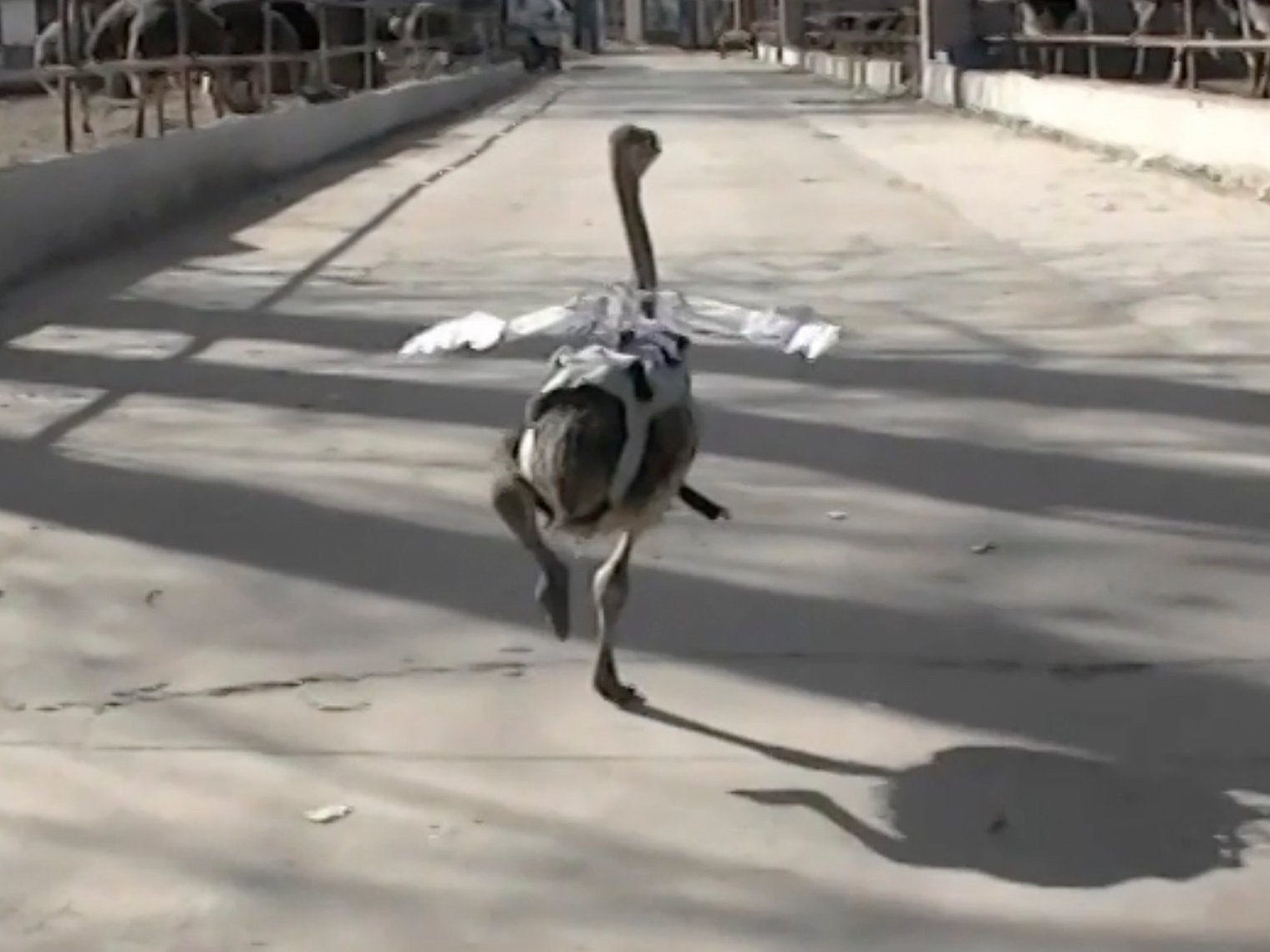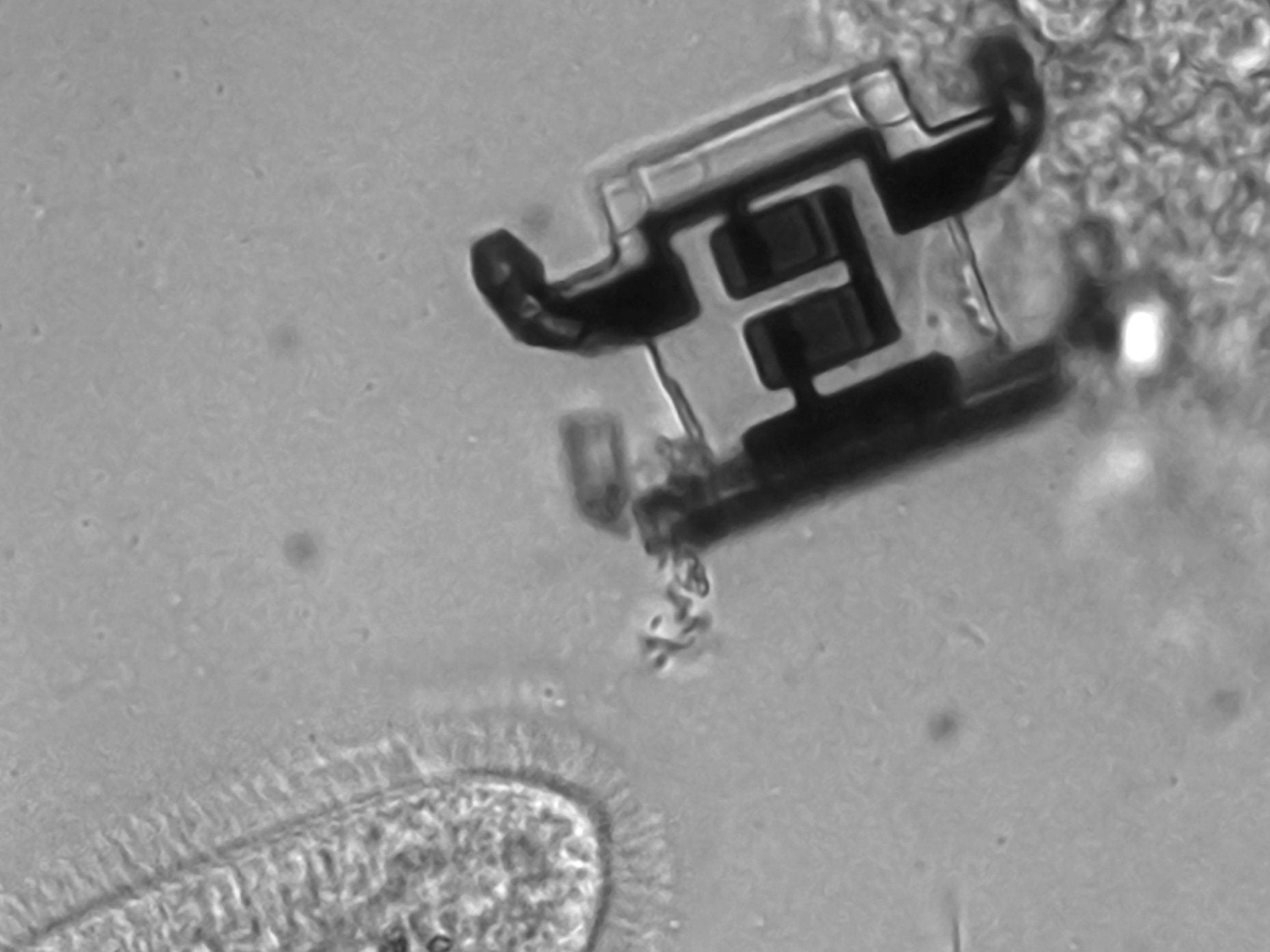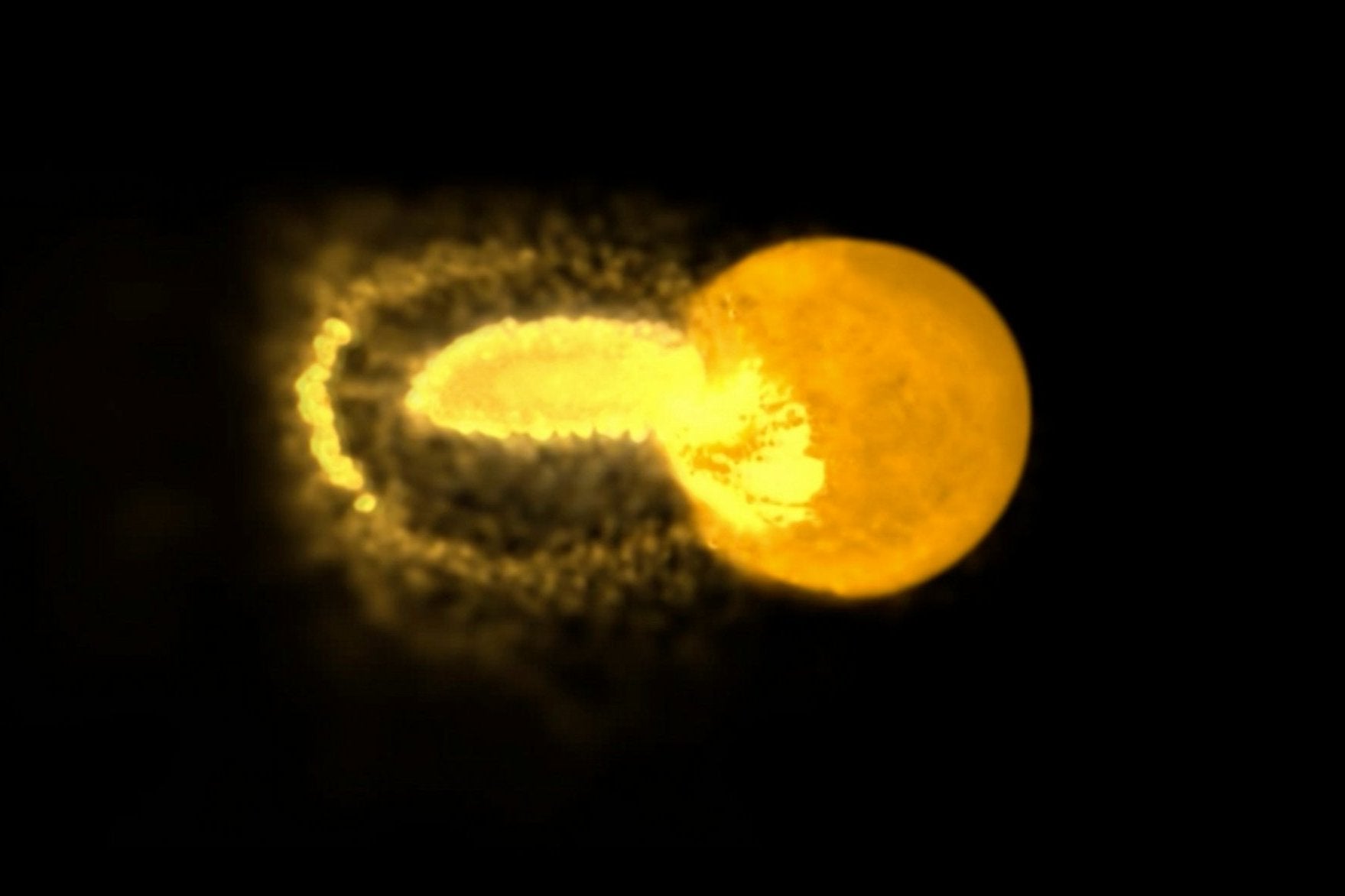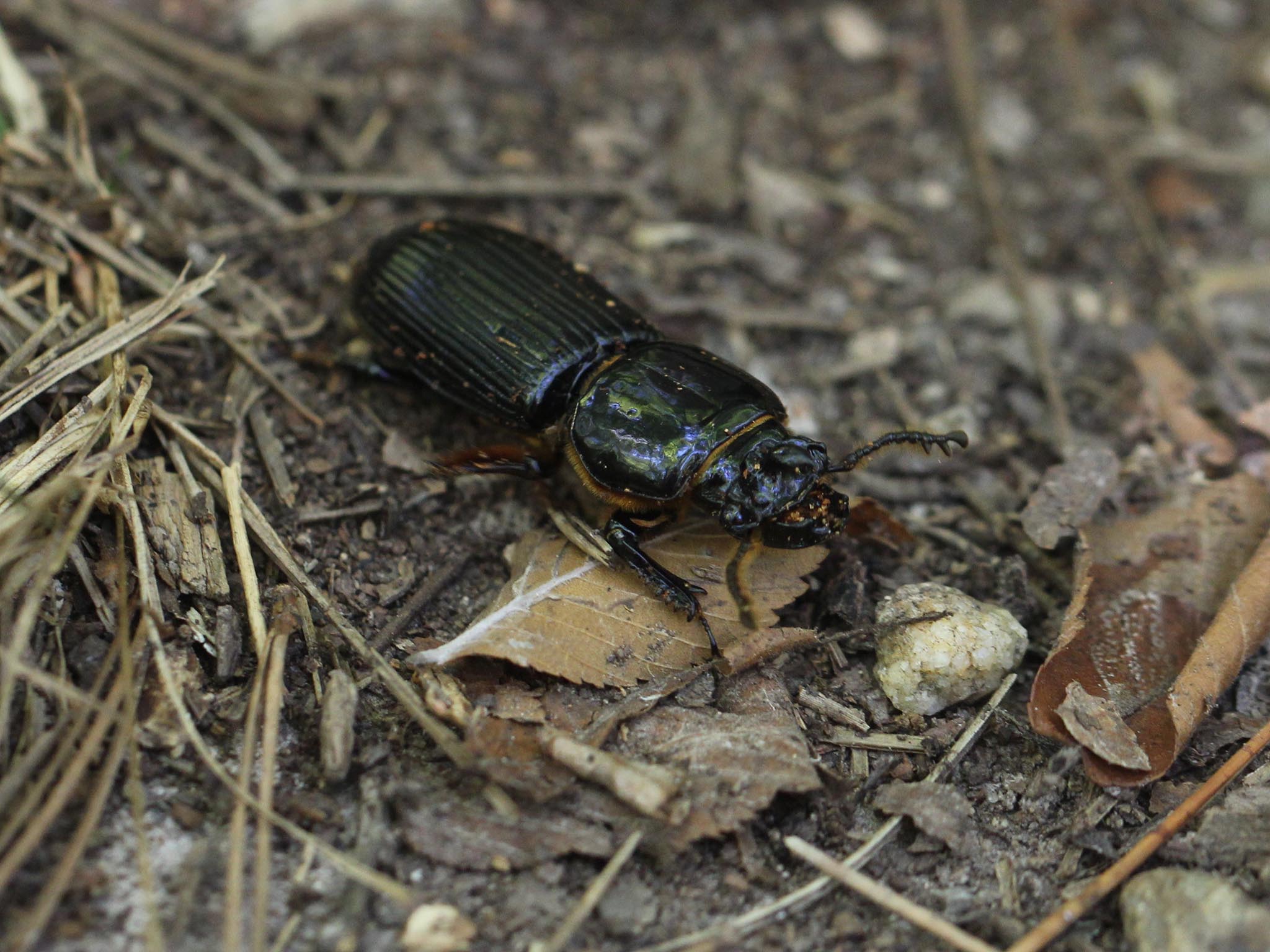Science news in brief: From microbots to the Moon’s creation
And other news from around the world

Why is this ostrich wearing an extra set of wings?
A young ostrich sprints down a path at a Chinese farm. His neck bobs, his legs pump – and the artificial wings attached to his back flap up and down.
Alas, this ostrich will not fly. He’s filling in for another earthbound creature, a dinosaur called Caudipteryx. Some 125 million years ago, this theropod walked on two legs and bore a pair of feathery “proto-wings”, similar to the fake ones worn by the ostrich. Recently, researchers set out to study the long-extinct creature as they took on one of the greatest controversies in palaeontology: how avian flight first evolved.
In a study published in PLOS Computational Biology, a team including mechanical engineer Jing-Shan Zhao and several palaeontologists used the outfitted ostrich – along with mathematical and robot models – to argue that when Caudipteryx ran, its mini-wings flapped involuntarily. Eventually, the researchers proposed, the dinosaur’s descendants would have harnessed this trait and taken off from the ground for the first time.
Other experts are less than convinced, arguing that the study’s analogues don’t do justice to the complexity of the animal it purports to study. But the disagreement itself highlights the unsettled nature of debates over the evolution of flight among the world’s feathered inhabitants.
“You’d be hard-pressed to find a palaeontologist who doesn’t have an opinion,” says Armita Manafzadeh, a doctoral student at Brown University who was not involved in the study.
Because modern birds evolved from a particular lineage of dinosaurs, the theropods, researchers look to them to figure out how flight began. Some promote a “top-down” theory, contending that winged dinosaurs learned to fly by climbing trees and gliding from the branches, not unlike flying squirrels. Others are on the “ground-up” side, positing that dinosaurs went airborne by running and flapping. Others question the dichotomy itself, arguing that the two theories are not mutually exclusive.
For their entrance into the fray, Zhao’s group performed three experiments. All focused on Caudipteryx – a useful organism for studying “the evolution from the earliest dinosaur to the modern bird”, says Zhao, who teaches at Tsinghua University in Beijing.
For the first experiment, the group used fossil analyses to develop a simplified mathematical model of the dinosaur. They then simulated a running motion in the model’s legs, and calculated how other parts of the body responded. They found that at a fast enough clip – between 5.5 and 12.9 mph, a range within Caudipteryx’s estimated capability – the model’s wings flapped.
For the second test, they built a robo-Caudipteryx and ran it on a treadmill. Here, too, they observed consistent oscillation, even as they increased and decreased wing length.
Then it was time for a live test. Zhao and his colleagues built a harness with force sensors and a set of wings. They augmented many different birds, including ducks and geese, before settling on the six-month-old ostrich.
As the ostrich ran, flapping was evident, and the sensors measured a small amount of lift: the motion was counteracting some of the bird’s body weight. Zhao suggests that Caudipteryx might have noticed that the weird thing its wings were doing was actually making it easier to run, and leaned into it. In this way, the passive jostling provided “basic training for later flapping flight,” he says.

The microbots are on their way
Like Frankenstein, Marc Miskin’s robots initially lie motionless. Then their limbs jerk to life.
But these robots are the size of a speck of dust. Thousands fit side-by-side on a single silicon wafer similar to those used for computer chips, and, like Frankenstein coming to life, they pull themselves free and start crawling.
“We can take your favourite piece of silicon electronics, put legs on it and then build a million of them,” says Miskin, a professor of electrical and systems engineering at the University of Pennsylvania. “That’s the vision”.
He imagines a wealth of uses for these microbots, which are about the size of a cell. They could crawl into cellphone batteries and clean and rejuvenate them. They might be a boon to neural scientists, burrowing into the brain to measure nerve signals. Millions of them in a petri dish could be used to test ideas in networking and communications.

The new robots take advantage of the same basic technology as computer chips. “What we’re doing is stealing from 60 years of silicon,” says Paul McEuen, a physicist at Cornell University. “It’s no big deal to make a silicon chip 100 microns on a side. What didn’t exist is basically the exoskeleton for the robot arms, the actuators.”
Miskin expects that he can demonstrate practical microbots within a few years.
He says: “It really boils down to: how much innovation do you have to do? And what I love about this project is for a lot of the functional things, the answer is none. You take the parts that exist and you put them together.”

A violent splash of magma that may have made the moon
The moon is far more than a largely dead orb. Our planet’s pale satellite is the creator of tides, the catcher of meteors and the only other world in the starry ocean where humanity has set foot. But scientists are still not entirely sure how it was made. Solving this mystery would not only reveal the moon’s origins, it would also help explain our own planet’s evolution.
A study published in Nature Geoscience suggests that the moon was forged from the fires of an ocean of magma sloshing over baby Earth’s surface. If correct, this model may solve a long-standing paradox.
Lunar meteorites and samples collected during the Apollo missions show that the moon and Earth have remarkably similar geochemical fingerprints. Scientists suspect that this was likely the result of a giant impactor the size of Mars, known as Theia, that slammed into a young Earth and sent into orbit a spiral of material that coalesced into the moon.
Countless computer simulations show that this is possible, but there’s a problem. Such an impact on a relatively solid Earth would have created a moon made mostly out of Theia, not Earth (at least in simulations resulting in the Earth-moon system we observe today, complete with our 24-hour days).
Attempting to solve this paradox, some models have opted for more high-energy impacts, according to Bill Bottke, a planetary scientist at the Southwest Research Institute in Boulder, Colorado, who was not involved with the Nature Geoscience study. These models excavate more of Earth’s material for building the moon, but the moon’s orbit or Earth’s spin aren’t accurately reproduced without using convoluted workarounds.
The new research, led by Natsuki Hosono of the Japan Agency for Marine-Earth Science and Technology, adds what may be the recipe’s missing ingredient. During Earth’s earliest days, it was covered by a sheet of molten silicate rock. Hosono’s team wondered what would have happened if Theia had crashed into Earth at that time, rather than during a later, cooler, more solid phase.
The team used a standard moon-forming simulation but adjusted it to better replicate density changes throughout the objects. With these tweaks, they found that the magma ocean made all the difference.
Immediately after Theia’s impact, Earth’s hot, squishy layer would have violently cascaded into space in huge volumes. This material orbited and coalesced around the young Earth, forming a moon made of about 70 per cent terrestrial material, far more than in older, largely solid Earth models, which came out at around 40 per cent.
Robin Canup, an astrophysicist at Southwest Research Institute, said that this magma-ocean model moves us some way towards explaining the geochemical mirroring of both objects, while also reproducing the way in which Earth and the moon dance around each other. “It’s a very exciting result,” she says.

Parasites infect these beetles. It might be a good thing
In forests across eastern North America, wood-eating beetles chew through fallen logs. This helps break down wood and return nutrients to the soil. But many beetles become infected by the thousands with a common, parasitic worm that makes their insides look like a plate of moving spaghetti.
There’s little evidence the parasites are harmful. Instead, infected beetles seem to be bigger and eat more than uninfected ones, suggests a study published in Biology Letters. This increased consumption may help the forest cycle nutrients faster, benefitting the whole ecosystem.
“Everything is connected,” says Andy Davis, an ecologist at the University of Georgia who led the research. “Here’s a case where there’s a little tiny bug in the forest and it’s actually doing a service within the forest. It’s doing something important. But then there’s another bug that lives inside that bug that’s doing something important.”
The horned passalus, also called the bess beetle, is about the size of your thumb and weighs as much as two raisins.
A curved horn protrudes above its monstrous mandibles, which it uses to eat decaying logs from the inside out. It prefers hardwoods – oak or elm – which it chews and excretes as sawdust for microbes to break it down further. The beetle then re-eats this material, spitting out some for its young. About 70 to 90 per cent of bess beetles unintentionally also care for Chondronema passali, a parasitic nematode (worm) that drains its energy.
Davis noticed that parasitised beetles had trouble with tasks requiring fast bursts of energy, such as fighting other beetles, closing wounds or evading predators. But they didn’t seem bothered during everyday activities, and didn’t lose as much weight as uninfected beetles when subjected to stress – even with a belly full of worms. That got Davis thinking: “Maybe they’re somehow compensating for the energy drained by the parasites by eating more.”
To find out, he and Cody Prouty, a student in his lab and co-author, collected more than 100 beetles from the forest and housed them in old ice-cream containers with a moist piece of wood for munching. After three months, the pair determined how much the beetles had eaten by weighing the sawdust left behind. They weighed and measured the beetles, then dissected them to look for nematodes.
About 70 per cent of their subjects had parasites, and those beetles were larger and ate about 15 per cent more than those without parasites.
The study estimated that 10 adult beetles with parasites could break down a pound more wood in a year than uninfected beetles could.
“Parasites get a bad rap,” says Davis. “People don’t usually think of them that fondly. But perhaps if we start to look at them this way, maybe that will change.”
© New York Times
Join our commenting forum
Join thought-provoking conversations, follow other Independent readers and see their replies
Comments
Bookmark popover
Removed from bookmarks